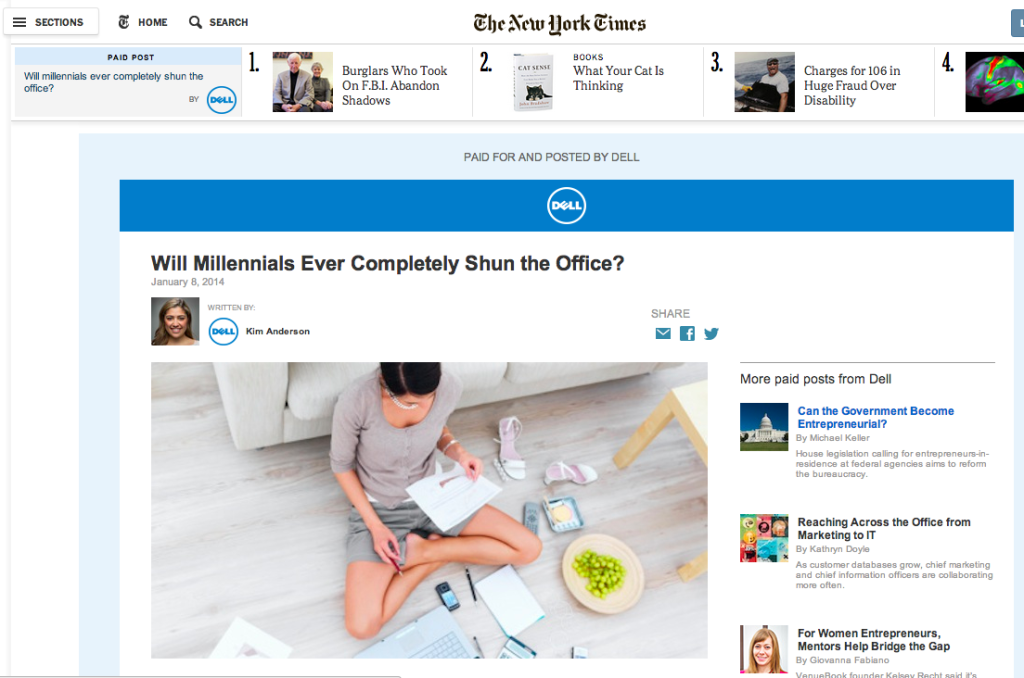Brands
A Review of The New York Times’ Sponsored Content Launch
The wait is over: The New York Times‘ sponsored content is here as part of its new redesign, with Dell as its first guinea pig.
Ever since the Times announced their pending foray into sponsored content in late October, they promised that they’d label it clearly—no surprise considering how critical the Gray Lady has been of sponsored-content practices. And without a doubt, the Times‘ “Paid Posts” set a new standard. The Dell posts feature a prominent Dell header, a light blue background, and a Dell logo next to the author byline. In addition, the Paid Posts use a different, smaller font than regular New York Times articles.
There’s also a “PAID FOR AND POSTED BY DELL” warning at the top of the page, which Digiday’s Brian Morrissey notes “is somewhat disingenuous since the Times technically does the posting, not the advertiser.” The Gray Lady had to land on common disclaimer language, though, and may eventually give brands permission to post on their own, like Forbes does with their BrandVoice product. That language will also protect the Times, should they ever end up with an Atlantic/Scientology-type debacle on their hands.
On the New York Times homepage, the Paid Post ad unit closely resembles other display ads and could never be mistaken for New York Times editorial. Clearly, they’re taking no chances.
Covering all bases, even the browser tabs are clearly marked:
And the Times clearly spells things out in a disclaimer at the bottom of the article:
“This page was produced by the Advertising Department of The New York Times in partnership with Dell. The news and editorial staffs of The New York Times had no role in its preparation.”
The Paid Post article page also promotes a set of New York Times articles selected by Dell, as well as three other Dell Paid Posts that were published today.
So what about the quality of the content?
Dell’s posts are solid, if unspectacular. “Will Millennials Ever Completely Shun the Office?” is the type of boilerplate story about the changing Millennial workforce that nearly every brand seems to write. So is “Reaching Across the Office from Marketing to IT“—a story about how CMOs and CIOs need to work together in an evolving marketing environment. There’s nothing wrong with these cleanly written, stat-heavy stories; they’re just nothing new. While working in branded content the past three years, I’ve probably seen a brand post some version of each 200 times.
“For Women Entrepreneurs, Mentors Help Bridge the Gap” is a more interesting piece of brand storytelling. The article tells the story of Kelsey Recht, founder of Venuebook, who has been able to “bridge the [gender] gap” that plagues the tech world with the help of fellow female entrepreneurs.
What about brand promotion? You’ll only find one piece of it. The fourth article, “Can the Government Become Entrepreneurial?,” includes a plug for Dell’s own EIR (entrepreneur-in-residence) program.
For the Times and Dell, it’s a safe start. But considering the brand equity and audience brands will be borrowing from the Times—not to mention the Paid Posts’ undoubtedly hefty price tag—it’d be great to see fresher, more groundbreaking Paid Posts in the near future.
What’s the deal with The Content Strategist? It’s something we created at Contently because we believe in a world where marketing is helpful, and businesses grow by telling stories that people love. Take advantage of our tools and talent and come build that world with us.
Image by Stephen Rees / Flickr.comGet better at your job right now.
Read our monthly newsletter to master content marketing. It’s made for marketers, creators, and everyone in between.






